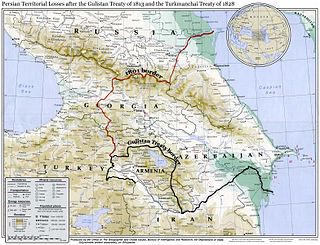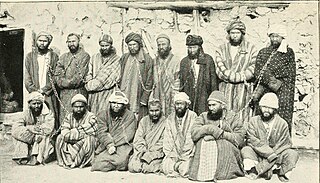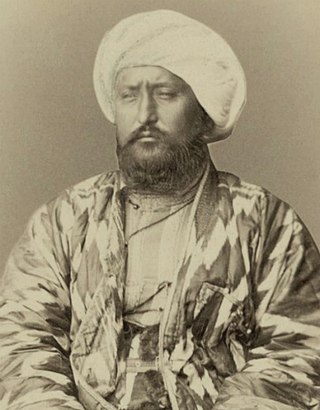Related Research Articles

The Treaty of Gulistan was a peace treaty concluded between the Russian Empire and Qajar Iran on 24 October 1813 in the village of Gulistan as a result of the first full-scale Russo-Persian War. The peace negotiations were precipitated by the successful storming of Lankaran by General Pyotr Kotlyarevsky on 1 January 1813. It was the first of a series of treaties signed between Qajar Iran and Imperial Russia that forced Persia to cede the territories that formerly were part of Iran.
This is a timeline of major events in the Muslim world from 1400 AD to 1499 AD.

Jahanghir Khoja, Jāhangīr Khwāja or Jihangir Khoja, was a member of the influential Afaqi khoja clan, who managed to wrest Kashgaria from the Qing Empire's power for a few years in the 1820s but was eventually defeated and executed.

The Khanate of Kokand was a Central Asian polity in the Fergana Valley centred on the city of Kokand between 1709 and 1876. Its territory is today divided between Uzbekistan, Kyrgyzstan, Tajikistan, and Kazakhstan.

The Khanate of Khiva was a Central Asian polity that existed in the historical region of Khwarazm from 1511 to 1920, except for a period of Afsharid occupation by Nader Shah between 1740 and 1746. Centred in the irrigated plains of the lower Amu Darya, south of the Aral Sea, with the capital in the city of Khiva. It covered present-day western Uzbekistan, southwestern Kazakhstan and much of Turkmenistan before the Russian conquest at the second half of the 19th century.

The Emirate of Bukhara was a Muslim-Uzbek polity in Central Asia that existed from 1785 to 1920 in what is now Uzbekistan, Tajikistan, Turkmenistan and Kazakhstan. It occupied the land between the Amu Darya and Syr Darya rivers, known formerly as Transoxiana. Its core territory was the fertile land along the lower Zarafshon river, and its urban centres were the ancient cities of Samarqand and the emirate's capital, Bukhara. It was contemporaneous with the Khanate of Khiva to the west, in Khwarazm, and the Khanate of Kokand to the east, in Fergana. In 1920, it ceased to exist with the establishment of the Bukharan People's Soviet Republic.

The Khanate of Bukhara was an Uzbek state in Central Asia from 1501 to 1785, founded by the Abu'l-Khayrid dynasty, a branch of the Shaybanids. From 1533 to 1540, Bukhara briefly became its capital during the reign of Ubaydallah Khan. The Khanate reached its greatest extent and influence under its penultimate Abu'l-Khayrid ruler, the scholarly Abdullah Khan II.
`Alimqul was a warlord in the Kokand Khanate, and its de facto ruler from 1863 to 1865.

The Andijan uprising of 1898 was a nationalist rebellion which occurred on 29 May [O.S. 17 May] 1898. Around 1,500 armed men attacked the Russian forces at Andijan, under the direction of the Naqshbandi Sufi sheikh "Dukchi Ishan" (1856–1898). The attack saw the rebels surround the camp, taking the soldiers of the 20th Russian battalion by complete surprise. However, the Russian troops quickly regrouped and managed to rout the rebels. The uprising lasted about 15 minutes.

Nasruddin Khan, or Nasruddin Beg, was the last ruler of Khanate of Kokand, then a protectorate of the Russian empire.
The Palace of Khudayar Khan, known as the Pearl of Kokand, was the palace of the last ruler of the Kokand Khanate, Khudayar Khan. It is the most visited tourism attraction in Uzbekistan’s Fergana Valley.

Sayid Muhammad Khudayar Khan, usually abbreviated to Khudayar Khan, was a Khan of Kokand who reigned between 1845 and 1875 with interruptions. He was the son of Shir Ali Khan. During the reign of Khudayar Khan, the Khanate was suffering from a civil war and from interventions of the Emir of Bukhara. Subsequently, the Russian invasion into Central Asia first forced the Khanate to become a vassal of the Russian Empire, and in 1876 the Khanate was abolished as a result of the suppression of an uprising. In 1875, Khudayar Khan, who took a pro-Russian position, during the uprising had to flee to Orenburg in Russia. He died in exile.

In the 16th century, the Tsardom of Russia embarked on a campaign to expand the Russian frontier to the east. This effort continued until the 19th century under the Russian Empire, when the Imperial Russian Army succeeded in conquering all of Central Asia. The majority of this land became known as Russian Turkestan—the name "Turkestan" was used to refer to the area due to the fact that it was and is inhabited by Turkic peoples, excluding the Tajiks, who are an Iranian ethnicity. Upon witnessing Russia's absorption of the various Central Asian realms, the British Empire sought to reinforce India, triggering the Great Game, which ended when both sides eventually designated Afghanistan as a neutral buffer zone.
Muhammad Umar Khan was the Khan of Kokand from c. 1810 until his subsequent illness and death in c. 1822. He studied at a madrassa after completing his primary education before seizing power from his brother Alim Khan. His poetry written under the pen name "Amir" touched on subjects spanning from humanism, culture, and enlightenment in diwans covering twelve genres. His teenage son Muhammad Ali Khan was given the title of Khan after his death.
Narbuta Bek was the Khan of Kokand from c. 1764 to 1801. He was the grandson of Abdul Karim Bek his only successor of not killed by Irdana Bek in a coup for power. He had three sons: Alim, Umar, and Shahrukh. His son Alim succeeded him as khan until he was overthrown by Umar.
Shir Ali Khan was the Khan of Kokand from June 1842 to 1845. He belonged to the Ming tribe that ruled Kokand.
Murad Beg Khan was briefly the Khan of Kokand in 1845, after he killed Shir Ali Khan.
Muhammad Amin Bahadur Khan, was the 7th Khan of the Uzbek Kungrat dynasty in the Khanate of Khiva. He reigned between 1845 and 1855, when he was killed in battle.
Abdul Mejid was a Kabuli mullah and merchant who explored Central Asia on behalf of the British Empire.
References
- 1 2 3 Howorth, Henry (1880). History of the Mongols, from the 9th to the 19th Century. Part II division II. The so-called Tartars of Russia and Central Asia. Londres: Longmans, Green and Co. ISBN 978-1402177712.
- ↑ Bosworth CE The new Islamic dynasties. A chronological and genealogical manual. NY, 1996. P. 295
- 1 2 3 4 OʻzME. Birinchi jild. Tashkent, 2000
- ↑ Waller, Derek (1990), The Pundits: British Exploration of Tibet and Central Asia, Asian History, Vol. I, Lexington: University Press of Kentucky, p. 24, ISBN 0-8131-9100-9 .